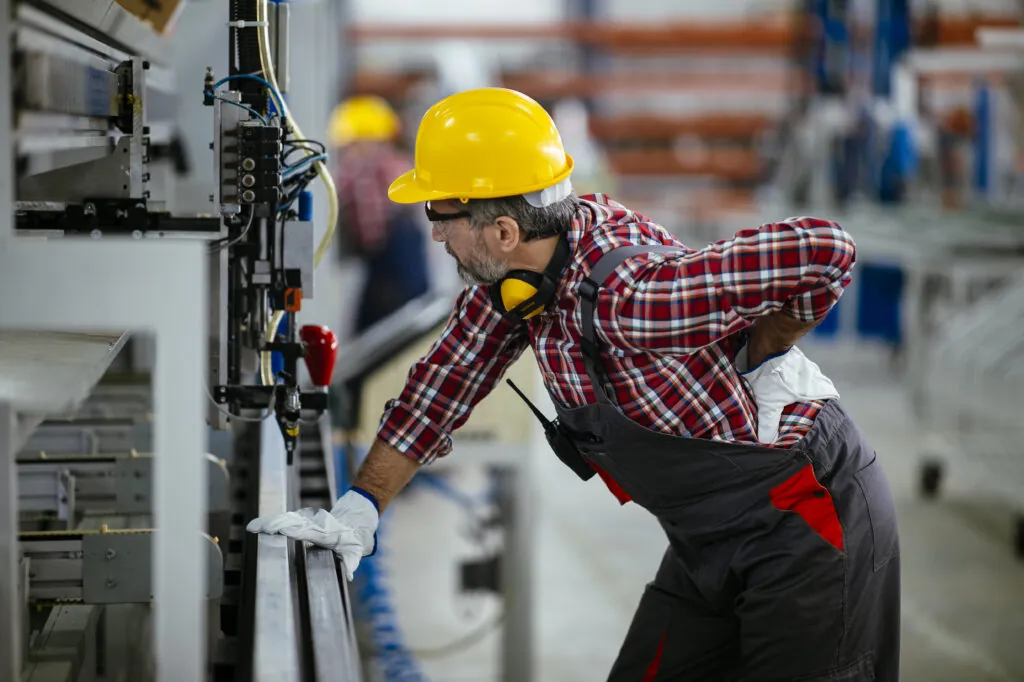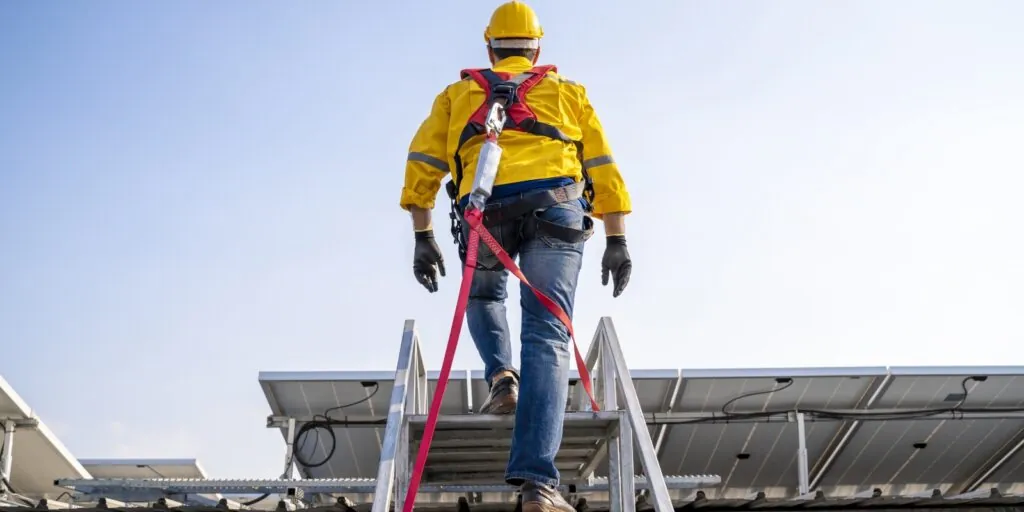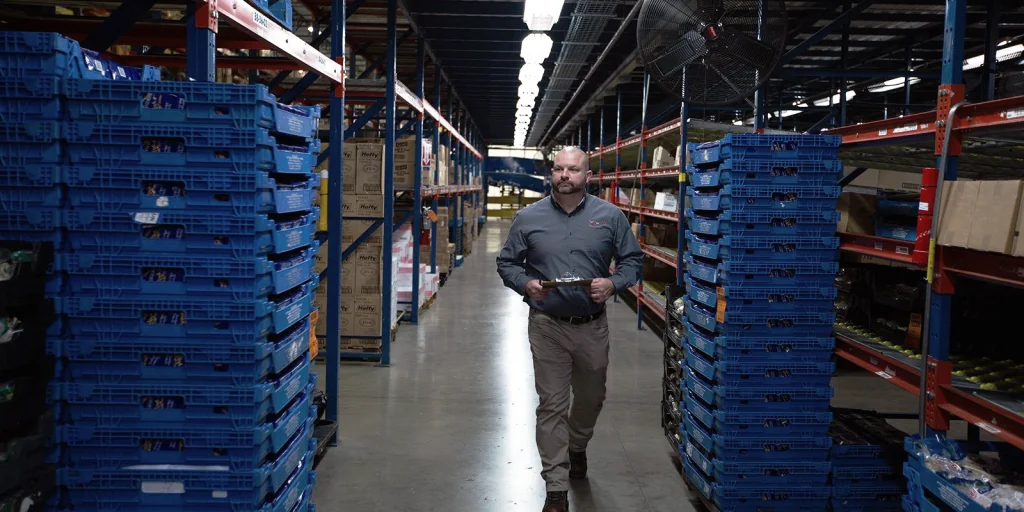By Riley Koenig, DAT, ATC, LAT
Injury Prevention Specialist, Fit For Work
Think back to a time you experienced hip pain or a lower-body injury—maybe a rolled ankle, sprained knee, or sore quads—that made you limp. If the discomfort lasted more than a day, you probably noticed sympathetic soreness in another area: the opposite hip, lower back, or even your shoulders.
Now, imagine working all day on a concrete plant floor, walking through a warehouse, navigating an uneven construction site, or sitting for hours at a workstation. The pain doesn’t just linger; it compounds. It’s cumulative, exacerbated by the environment, and it rapidly chips away at your mobility and function.
This is the reality for many industrial athletes—individuals whose jobs require consistent physical effort, endurance, and movement, much like traditional athletes. Their performance and safety depend on how well their bodies move, recover, and adapt to daily physical stress.
Maintaining hip health is vital for today’s workforce, as it is foundational for movement and performance of daily tasks – on and off the job.
A Strong Foundation
Healthy hips stabilize the body and link upper and lower body movement. As a ball-and-socket joint with a cupping mechanism, the hip allows for a wide range of movement. This joint is designed for heavy load bearing and force transfer, relying on surrounding muscle synergy for efficient motion. Working together, the hip joint and muscles provide the body:
- Strength – generating power for lifting, sprinting, and jumping
- Stability – working with the core to maintain balance and posture
- Mobility – providing flexibility to prevent strain on the knees and back
These functions are essential for industrial athletes who perform repetitive, load-bearing tasks or movements such as squatting, lunging, or walking during the workday.
Causes of Hip Pain
Hip pain can result from injuries, including slips, falls, and strains – or motions, such as repetitive lifting, twisting, or bending. Prolonged sitting in an awkward position or with poor posture is another source of strain and pain for the hips. Mature workers may experience underlying conditions such as osteoarthritis or bursitis, while both younger and older workers may feel the cumulative effects of past sports injuries. Sudden or nagging pain can cause employees difficulty performing their jobs, lead them to skip needed exercise, and result in disturbed sleep.
Who’s at Risk
High-risk occupations for hip pain or injury include construction, mining, manufacturing, transportation/warehousing, and even office environments. Hip injuries are often caused by accidents, with 95% of hip fractures related to slipping and falling. Jobs involving repetitive, heavy manual work nearly double the risk for hip osteoarthritis. Whole-body vibration and traversing thresholds while driving vehicles (e.g., forklifts) increases this risk by 50-60%. Sitting for ≥7.5 hours per day is associated with a 54% increased risk of hip pain in mature adults. Standing or walking on concrete, especially in cold environments, also aggravates hip joints and causes pain.
Hip Dysfunctions
Here are common hip issues we see in today’s workforce.
- Prolonged sitting/standing or repetitive lifting leads to tightness in the hip flexors, which causes hip discomfort, low back pain, and limited leg extension.
- Repetitive lifting can also lead to piriformis syndrome, where the sciatic nerve is irritated or compressed, causing numbness or tingling.
- Stationary twisting, heavy lifting, or rotations on the legs can cause damage to the hip labrum or cartilage, leading to pain and instability.
- Hip impingement is an injury where the bones of the hip joint don’t fit together properly, causing pain and reducing the range of motion.
- Overuse of the hip joint from repetitive squatting or weak hip abductor muscles can lead to lateral pain on the outer hip.
Unfortunately, pain in one part of the body leads to compensation in other muscles and joints as workers try to keep moving, increasing injury risk to other areas.
People with limited hip mobility often compensate by overusing their lumbar spine, increasing the risk of low back pain, which accounts for 15-25% of lost workdays in industry. The best solution is to analyze the cause of pain or injury, return the body to a healthy condition, and implement strategies to avoid future injury.
Injury Prevention Strategies
Hip discomfort and lower-body strain are common challenges across industries. Addressing these issues proactively can significantly improve employee well-being and performance.
Body Mechanics – Training workers in Six Steps to Safe Lifting helps establish a base of balance, engage the power zone, and maintain correct posture. Encouraging neutral hip alignment for bending, twisting, and standing improves load transfer, reduces injury risk and fatigue, while increasing endurance. Onboarding and periodic lifting labs can ensure that all employees apply these techniques to their daily tasks.
Ergonomics – Rotating tasks can help prevent repetitive hip loading, reducing the risk of overuse and fatigue. Limiting prolonged standing, squatting, or climbing and incorporating micro-breaks throughout the day can reduce cumulative strain and support recovery. These small adjustments make a big difference in long-term joint health.
Stretching & Mobility – Savvy employers are embracing stretching and mobility programs led by in-house athletic trainers to prevent injuries. These include dynamic warm-ups before physically demanding shifts. Daily hip mobility routines help maintain a proper range of motion, including stretches for hip flexors, glutes, hamstrings, and the piriformis muscle.
Additional strategies include promoting regular physical activity such as yoga or Tai Chi, ensuring footwear supports proper hip alignment, and using slip-resistant flooring and anti-fatigue mats to reduce discomfort. For seated roles, ergonomic chairs that support posture are essential.
Visual reminders like “posture check” posters can prompt workers to avoid slumping while sitting or standing to reduce strain on the hips, back, neck, and shoulders.
Understanding the specific job tasks involved, as well as anticipating the diverse needs of your workforce, can guide ergonomic adjustments that make work safer and more inclusive. For example, employees with larger or smaller body types may require modifications to ensure proper ergonomics on the job.
Conclusion
Understanding the needs of your workforce is essential to preserving their quality of life and long-term productivity. Hip health, often overlooked, is foundational to movement, stability, and the ability to perform daily tasks—both on and off the job.
When hips are compromised, the ripple effects can impact everything from posture and gait to endurance and injury risk. By proactively supporting hip function through smart ergonomics, movement strategies, and individualized accommodations, organizations can reduce lost-time injuries, meet operational goals, and empower employees to achieve their personal best.
Contact us to learn more about our early intervention and ergonomic services—and how we can help support hip health and injury prevention across your workforce.

Riley earned a Bachelor of Science in athletic training from Texas Lutheran University and went on to complete a Doctor of Athletic Training from Indiana State University. He began his career providing athletic training services through a hospital system, supporting local high school athletes. In 2021, he joined Fit For Work and now serves the San Antonio region, delivering onsite early intervention services across a variety of warehouse and industrial settings.
He’s passionate about promoting proactive health and wellness, with a strong interest in biomechanics, diet, and nutrition. Outside of work, Riley enjoys spending time outdoors and balancing a busy family life with his wife and two children—often hiking, biking, or caring for animals at home.





